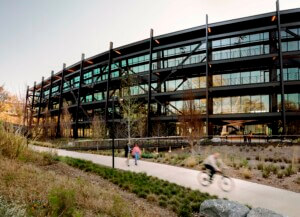In the United States, the architecture of power manifests itself in the stone edifice. Like the Roman and Greek precedents that gave rise to home-grown neo-Classical examples, stone is the material of choice for the monument.
Marble, to the Western world, appeals to the upper echelons of society due to its ability to connote the democratic ideals Greek and classical architecture represents. “More marble was used in building in the United States in the years 1900–1917,” wrote Marcus Whiffen, “than… in the Roman Empire during its entire history.”
Emphasizing the U.S.’s love of the eternal material, Whiffen continued: “Nowhere outside the United States were the classical orders… drawn up in so many parade formations.”
Of course, this is not to say that the style, or indeed use of marble, has come to an end. With typologies such as state capitols, courthouses (a phenomena well chronicled in Courthouses of the Second Circuit by the Federal Bar) and other governmental buildings that require a certain grandiose scale and presence, marble will be in demand for a long time to come.
The thirst for marble nevertheless continues and the supply may lie in the sleepy rural town of Tate, Georgia. Located upstate, two hours north of Atlanta, Tate has an established white marble pedigree. Now run by Polycor, the huge quarry has been mining marble for over 180 years, supplying much of the U.S. with its white and gray marble which has been used for many national landmarks and emblems of power, notably the New York Stock Exchange, Lincoln Memorial, and the U.S. Capitol. Now, it is also used for the vast majority of U.S. military gravestones.
Polycor has pioneered advancements in marble manufacture, developing a new 3/8″ (1cm) thick marble slab. This equates to being one third of the weight of a normal slab that is three times as thick, meanwhile the application of a proprietary composite backing increases the strength of the stone ten fold.
This development means that marble can now be used effectively in cladding systems. A notable failure of marble being used for cladding in the past can be seen with the Aon Center tower in Chicago (formerly the Amoco building). Once built, the Amoco building was the world’s tallest marble-clad building, utilising 43,000 slabs of Italian Carrara marble. While construction was still underway, however, on December 25, 1973, a 350-pound marble slab fell from the facade, puncturing the roof of the adjacent Prudential Center, an unwanted Christmas present. Now, thanks to the new stronger and thinner marble slabs, the material may once again be considered for such uses and indeed many more.










